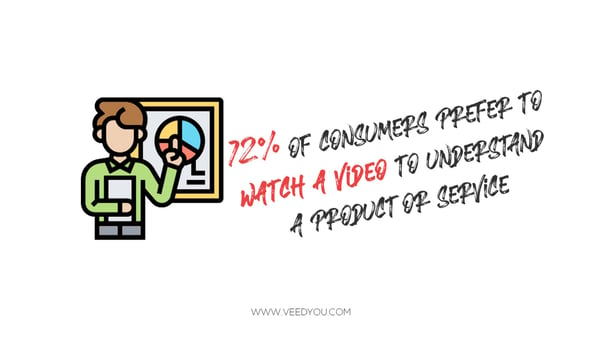
A stand-out product video compels consumers to pay attention.
It introduces the product or service and also informs about its features and functions. In addition, inspirational product videography subconsciously inspires the viewers to open their wallets.
Over the years, we’ve seen our fair share of product videos on various social media platforms. Some go viral and add millions of sales to their name, but the majority of videos are duds that disappear in the crowd.
If you want to create the best product videos, but don’t know ‘how to’ or ‘where to’ start, you’re at the right place. Let’s get cracking.
The old habit of examining a product before buying at a brick-and-mortar store has become part of our instinct. Consumers like to see and if possible, touch-and-feel the product before they make the purchase decision. Nowadays, this has become impossible for both online and offline buyers.
Consumers get vicarious experience by watching and listening to others handling and examining a product. Plus, product videography removes doubts and uncertainties that consumers have about the product.

With a product video, you get to control the narrative and expectations of the consumers. Viewers get more information from a video than a still photo or even actual physical examination of the item. Undoubtedly, consumers gain a better understanding of a product after watching it in a high-definition close-up view and from all possible angles. Videos also showcase the features and functions in action.
The persuasive power of still photos and text content pales compared to product videos. Plus, 72% of consumers prefer to watch a video to understand a product or service.
Product videography gives life and context to the item that’s displayed in the video. Sometimes, having the product in hand, consumers will never know how it can benefit them. But a well-made product video can transform an item into one that becomes an essential part of the consumer’s life.
The vision of a pair of expensive running shoes is replaced by the pleasant experience of jogging early morning with a friend or partner. Instead of a sewing machine, a stand-out product video will trigger the thought of beautiful clothes that one can make for their kids with the machine. Customers get to see what the product is and also what it can be.
With the help of real-time product videos, consumers can see the options available at the physical store before making a choice.
Here is how real-time ‘virtual’ shopping works: A person searches for a smartphone online. On an e-commerce website, the consumer finds a suitable product. On the portal, he/she finds an option to speak to the retailer. The consumer shares a phone number and through VoIP instant messaging or through a browser VoIP call, the customer can speak with the retailer.
Through a live streaming option on the website, the customer sees the array of products in the physical store. A sales assistant at the retailer’s end guides the customer and shows the various products and options available. With the help of a real-time product video, customers can see the actual product before buying.
Most products are designed by middle-aged people, even if the target market is teenagers. The best product videos bridge this gap and help you reach your target audience.
Experienced video marketers create videos that speak the language of your prospective customers. Experts know what words to include and what not to use in the video. Well-made video content with the right script, right language, and right tone help the target audience relate to the product in the video.
Consumers, a large majority of them, are still uncertain about buying online. There is always a doubt whether an item would match their expectation. There is always a tinge of uncertainty about product quality and performance.
Product videos help demonstrate the working of the item. It encourages the customer to see the product’s value. Stand-out video content helps build an understanding of the item and also shows the viewer how the item works.
Customers can’t touch or feel the product, but they can see it inside-out. All the key features, functions, and benefits are displayed. This gives the consumer the knowledge and confidence to overcome the uncertainty and make the buying decision.

The greatest blunder you can make is to start filming without a plan. We aren’t going into the nitty-gritty of location, background, color, font, sound, etc. and we are not going to break the bank with this video. But, at the least, you must have a basic idea of the end product before you even start making the product video. If you’re a newbie, wanting to know how to make a product video, here are the basic ingredients of a good product video.
If the product video is on a social media platform, it’s likely the consumer has stumbled upon it by chance. Make the best first impression by introducing your company and the product.
How to give a crackerjack introduction? Touch upon the common pain points your target audience face. Make them feel you understand the problem and have a solution. Present your company and the product as the answer to their needs or solution to their problem.
Videos that only show the product are no better than still photos and text content. People seeing the product for the first time don’t know the features, functions, and the benefits they might derive from the item. A video devoid of details about the features won’t inspire viewers to become customers.
Show off the product, its features, and don’t hesitate to say who will benefit from using it. Sometimes the viewers are confused about whether they need the product or not. Spell out who will benefit and how the product will benefit the viewer to remove all doubts and confusion.
The best product videos don’t just show the product and its features. They go a step further and explain how the product fits in the customer’s life. The video must provide answers to questions like ‘How does the product increase the customer’s happiness?’ ‘How does the product enrich the buyer’s life?’
In the eyes of a customer, a product video that shows the product, features, and benefits is still incomplete if it doesn’t include the price. Keep in mind that your first goal is to make the consumer watch the full video. You fail if the viewer searches for the price of the product elsewhere.
Provide the prospective customer with ‘all’ the information needed to make a decision, including the cost of added features. There is a good chance of losing a customer forever if he/she finds there are hidden costs involved and the cost of added features wasn’t revealed before the buying decision was made.
The whole point of having a product video is to create awareness and boost sales. Ideally, this goal can be achieved only by including a clear call-to-action (CTA) at the end of the video. Consumers who sit through the video to reach the CTA stage demonstrate a clear interest in the product. Make use of the ‘intent’ to guide the consumer to the next stage of the buying journey.
You can have the actor or narrator spell out what’s expected of a viewer, but the old fashion method of adding an on-screen CTA text is still the way to go. Append a simple and easy-to-understand call-to-action that tells the consumer what to do next.
Along with the CTA, provide the prospective customers with the information they need to follow-up. The details you add here depend on your goal for the product video. Suppose the video is on a social media platform, the viewer might need more convincing and less distraction. So, lead the customer to your website or product page where you can control the elements such as the customer’s experience and the content he/she views.
For example, ‘Get Buck Mason Tees’ can be followed up by providing a link that’ll take the consumer to the product page. Similarly, ‘Call Wilmac Plumbing Now’ CTA must have the phone number of the company.
From what we’ve learned so far, it has become quite clear that a product video is a lot more than the product. To create the sort of impact in people that you want, the video must discuss a bunch of ideas such as the problem the customers face, the solution the product offers, the experience guaranteed by the product, and the larger vision you want to build about your brand.
Want to know how the best product videos put the above-mentioned points into action? How the videos vary in detail and pace but are alike in the impact they create on the consumers? Here are three product videos that can inspire you to create a stand-out product video.
No list of product video examples is complete without the Dollar Shave Club. The brand shook the internet, made waves, and put their product on the map with their first video.
We encourage you to watch the video again before continuing with the article. You may want to use the headphones if kids are around; the makers don’t shy away from using strong language.
Watching the video, donning the hat of an analyst, one can very well notice the company’s clear understanding of their target audience and the problem for which they are offering a solution.
The language and message used in the video are tailored to the demographics that are most likely to buy their product. The company’s target audience is young professional men who spend their hard-earned money at local stores buying big-brand razors.
The problem that Dollar Shave Club is promising to solve is the ridiculously high cost of cartridges. The company promises to solve the problem by offering affordable razors through their subscription service.
To highlight the problem and present a viable solution, what was required is a well-targeted product video with an interesting script, casual language and tone, a sprinkle of humor, and faultless execution. The Dollar Shave Club product video has all that and more.
The script for the product video came from Michael Dubin – the CEO of Dollar Shave Club – himself. He was part of the Upright Citizens Brigade group, where he trained in improvisational and sketch comedy. Lucia Aniello, who has worked in Comedy Central, produced the video. The product video made at a cost of $4500 has so far garnered more than 11 million views and mentions in almost all major media publications.
When a brand and product is new, not burdened by the weight of expectations, drawing attention using a product video is relatively easy. The same can’t be said if the goal is to reinvigorate the popularity of a product with little or no changes.
Here is an example of a company known for creativity and innovation in their marketing campaigns. The brand in question – Apple – has been around for a long time. Millions around the world discuss, write, and speculate on the products and launch events.
Even for a brand like Apple, creating a stand-out video for an existing product with some new features and enhancements must be a challenge. But, the brand met the challenge head-on and aced it. In the process, Apple has taught a valuable lesson on how to make a product video.
In its ad for the iPhone 6s, Apple stitches an array of small enhancements and presents them beautifully to the viewers. You don’t need words to understand the new enhancements. In this product video, the visuals speak louder than words. The color, clarity, creativity, music, and the product are sure to attract attention and occupy your thoughts for a long time.
Searching for the best product videos took us back to 2006 when Tom Dickson – the CEO of Blendtec Blenders – introduced the “Will it blend?” marketing campaign on YouTube. Even big brands with loads of money to spend on marketing have not managed to do what Blendtec has done.
Following the phenomenal success, the campaign fanned out to other social media networks. The company even invited suggestions for things to blend. The viral marketing campaign has its own Wikipedia page.
Why did the marketing strategy succeed? The success of Blendtec’s campaign is due to two common points in all their videos: the message (Blendtec blenders can blend anything) and the personality of the brand (the openness to tackle any challenge to prove the toughness of their blender blades).
For nearly a decade and a half, the show has blended chips, toys, compact discs, chicken, and even iPhone and other Apple products. On YouTube alone, the ‘Will it blend?’ series has amassed more than 285 million views. In one of the interviews, Tom Dickson said the instant success of the campaign has had a tremendous impact on the sales of their retail products.
Making a product video is challenging and it involves a lot of hard work. Even after pouring your heart and soul into the process if the outcome doesn’t perform as expected, your enthusiasm will soon turn into anguish.
You can avoid the pitfalls that many product videography creators face by using this blog post as the primer and guide. Follow the tips and take inspiration from the examples before you begin work on your video. We guarantee that you’ll have a product video that you’re proud to show to the world.
Make sure your product videos are flawless – use the best video editing software on the market to make your product videos shine.
Cristian Stanciu is a freelance video editor and the Founder of Veedyou, a platform offering video editing services to clients all across the globe.
From 467 million users in Q3 2016 to 590 million by the end of 2018, LinkedIn’s growth has...
 by Taru Bhargava
by Taru Bhargava
From bad acting to boring content, training videos can sometimes get a bad reputation.
 by Mara Calvello
by Mara Calvello
It's February, and that means you're probably halfway through the implementation phase of your...
 by Kai Tomboc
by Kai Tomboc
From 467 million users in Q3 2016 to 590 million by the end of 2018, LinkedIn’s growth has...
 by Taru Bhargava
by Taru Bhargava
From bad acting to boring content, training videos can sometimes get a bad reputation.
 by Mara Calvello
by Mara Calvello


